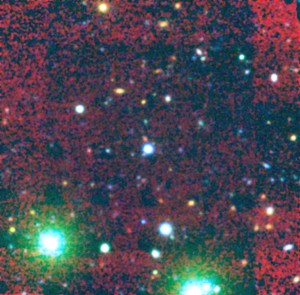
Artist’s impression of a very distant quasar powered by a black hole with a mass two billion times that of the Sun. (Image: ESO/M. Kornmesser via Wikimedia Commons)
Scientists have found the largest known structure in the universe, a cluster of galactic cores so vast it would take four billion years for a spacecraft traveling at the speed of light to cross it.
The sighting challenges a theory from Einstein which suggests such a massive object shouldn’t exist in the universe.
A quasar is the compacted center of a galaxy surrounding a massive black hole from the early days of the universe. Quasars go through periods of extreme brightness which can last anywhere from 10 to 100 million years. They tend to band together in enormous clusters, or structures, forming large quasar groups (LQGs).
The international group of scientists led by Roger Clowes from the University of Central Lancashire’s Jeremiah Horrocks Institute, used data from the Sloan Digital Sky Survey (SDSS), a major surveying project that uses 2.5-m wide-angle optical telescope located at New Mexico’s Apache Point Observatory, to make their findings.
Clowes and his colleagues are astounded by the size of this structure, which defies the Cosmological Principal, based on Albert Einstein’s theory of General Relativity that assumes when you look at the universe from a sufficiently large scale; it looks the same no matter where you are observing it from. The Cosmological Principle, according to the research team, is assumed but has never been demonstrated observationally ‘beyond reasonable doubt.’

Large quasar group (LQG) as imaged by the Big Throughput Camera at the Cerro Tololo Inter-American Observatory in Chile (Photo: Chris Haines)
“While it is difficult to fathom the scale of this LQG, we can say quite definitely it is the largest structure ever seen in the entire universe,” said Clowes. “This is hugely exciting, not least because it runs counter to our current understanding of the universe. The universe doesn’t seem to be as uniform as we thought.”
Clusters of galaxies can be anywhere from six to 10 million light-years across, but the LQGs can be 650 million light-years or more across. Making calculations based on the Cosmological Principle, along with the modern theory of cosmology, astrophysicists shouldn’t be able to find a structure in the universe larger than 1.2 billion light-years, much less four billion light-years across as this newly sighted structure is.
To get some additional perspective of what the astronomers found, let’s step back and give it a sense of scale. Our own galaxy, the Milky Way, is separated from its nearest neighbor, the Andromeda Galaxy, by a distance of 2.5 million light-years.
Clowes points out that his team’s discovery does have a typical dimension of 1.6 billion light-years. But, because it is elongated, its longest dimension is four billion light-years, making it about 1,650 times larger than the distance from the Milky Way to Andromeda.



 Science World is VOA’s on-air and online magazine covering science, health, technology and the environment.
Science World is VOA’s on-air and online magazine covering science, health, technology and the environment.